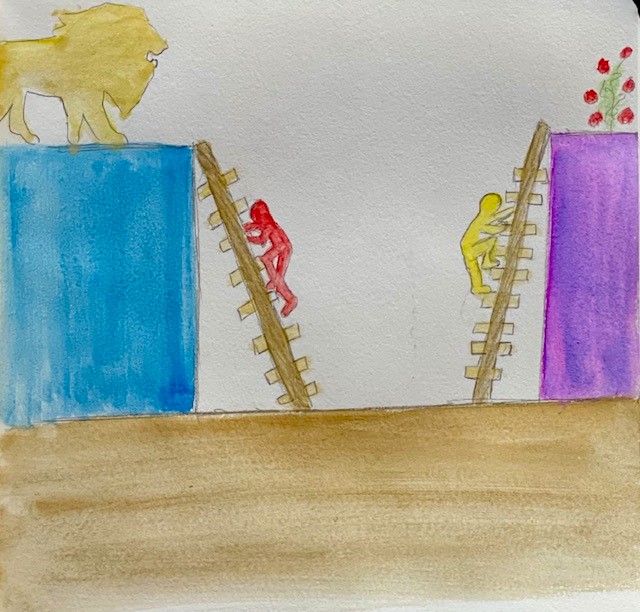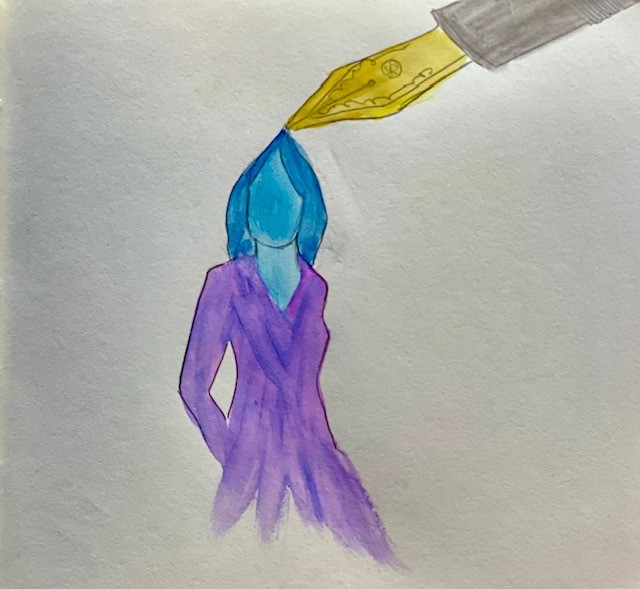I’m fascinated by the confluence of storytelling, leadership development and improvisation. Most recently, the way that’s been showing up in workshops and coaching conversations is through the stories we tell about ourselves – both to ourselves and to others. And the thing is, how we choose to tell those stories, be it through the words we choose, the tone we adopt, or the meaning we give events, is a source of untapped power.
Literary critic, memoirist, and essayist Thomas Larson writes in “The Past is Never Over” that to write memoir, writers need to once again open themselves up to the full experience of their pasts, that they need to viscerally engage with it now to make meaning of what happened then. For me, that concept was unexpected and daunting when I encountered it in my first semester of my MFA program. Brené Brown’s courageous vulnerability on the page, as authors cultivate the discipline, strength, and resilience to tackle our most formative experiences and translate them into powerful stories for the benefit of others.
This is what master coach Martha Beck calls light writing, writing that she says is “about writing into the sources of suffering [small or large], discerning their nature and meaning and how to resolve them, and then writing out into a resolution that is enlightening to yourself and the world.”
In creative nonfiction, an author revisits their past with the full engagement Larson talks about while also deriving new meaning from experiences thanks to the people they have become in the interim. The “I-Now” of the writer finds new meaning (perhaps ownership, agency, compassion) in the actions and experiences of the “I-Then,” the writer’s former self who experienced the events.
As bestselling author and University of Iowa professor Melissa Febos says, “Self-knowledge, the insights unavailable in the past and acquired in the time since, are what give memoir its depth…For me, as I believe for most memoirists, the process of writing is also a process of comprehension, an examination of the past that yields new understanding.”
And lest you say, “But I’m not a writer – the last thing on earth I want is to write out personal stories and have other people read them,” please remember that we think, dream and speak in stories. Stories are wired into our DNA and into our cognitive processes.
Don’t believe me? Just think back to the last time you had a few pieces of information about a situation at work or in life, and ask yourself what you did with those disparate pieces of information.
Chances are, you filled in the gaps in your knowledge in a way that placed those scattered pieces of information into some narrative that made sense.
That’s what a story is. In fact, Ira Glass says exactly that: “a story is a sequence of events with meaning.” So if the President of our organization comes into work, doesn’t smile or say hello to anyone and walks straight into the VP’s office and closes the door, then emerges and walks quickly to the Director of HR’s office with the VP in tow, where again a door is closed, and then the President’s Executive Assistant emails an announcement that the standard weekly staff meeting has been delayed and instead summons our unsuspecting coworker to meet with that grim group of higher-ups, we’re going to make up a story that puts those discrete events into a sequence that has meaning. And chances are, somebody’s getting fired at the end of that story we invented in just a few minutes of silent observation.
This is why transparency in leadership is critical. If we don’t share with people what’s going on – to whatever degree we’re able – they’re going to draw their own conclusions. Not because they aren’t willing to give others the benefit of the doubt, but because they’re human.
We are all constantly trying to make sense of the world around us, and that starts when things we see and hear hit the amygdala, the emotion center of our brains. Once we’ve made the snap decision as to whether we’re being faced with a threat or a potential reward, only then does the information we’ve perceived through our senses work its way through the rest of our brains until we finally have a chance to rifle through our memory banks for past experiences that might help us make sense of what we’re currently experiencing.
There are all kinds of advantages to this: conserving energy, learning from past experiences, not getting eaten by a sabretooth tiger. But unfortunately, there are some downsides, too.
Like, what if we’ve made up a story about ourselves that’s getting in our way (“I’m too collaborative to be CEO.” “I’m too driven to action and results for people to think I’m fun and want to include me social events.” “I can’t be successful and also have a happy life outside of work.”)
What if a story that we came by honestly – one that makes perfect sense given our past experiences and that has served us in the past starts to get in our way?
Shirzad Chamine’s Positive Intelligence program delves deeply into this concept (Yes, we all have survival instincts that we depend on; and, how can we be at choice in the times when those defense mechanisms get engaged even though we’re not truly threatened). Simiilarly, Dr. Kristin Neff has some great work around the concept as it relates to overidentifying with one aspect of our personalities (Yes, we can act responsibly, but how is that different when we start thinking of ourselves as Responsible? How does that narrow our field of opportunity for complexity and growth?)
Now, Let’s be clear: there is a place for acknowledging what sucks and processing the hard stuff in life. And sometimes, we’re going to need immense support, time, and/or therapy to do that.
What I’m talking about here is different. I’m talking about the times when we are fully resourced and have the insight and agency to make a choice as to whether we want to further contribute to our own small-s suffering, or if we want to take the risk of authoring our own story.
For example, take one of my coaching clients from a few years back who was given a seemingly terrible choice in the midst of a workforce reorganization: volunteer to leave, or be demoted to a lower status job he didn’t like. Later, his coworkers said he’d been let go to which he replied, “No. I chose to leave.” Similar conclusions, both drawn from the facts of the reorg, but my client chose the one that empowered him and set him up for success. And that made all the difference in his transition.
As Ben Zander says, the meaning we choose to link disparate facts are all invented, so why wouldn’t we construct the narrative that makes us happiest and most likely to accomplish more of what we want in life? I’m not saying we should ignore reality or deny the truly negative and hurtful things in life. But when we find a story we’re telling – in our own minds or to others – that hurts us in some way, that makes us feel bad, dumb, less-than, instead of unconsciously continuing to tell that story, we could instead interrogate it. We could get curious about our own ladders of inference and ask ourselves, “What else might have been inferred from the same data, the same objective facts?”

We can extrapolate from The Work of Byron Katie and imagine what would be possible if we were liberated from this old story. And, we could ask ourselves what story we wish were true, envisioning new opportunities.
Once we’ve interrogated our standard stories, we can choose to reclaim them and continue telling them consciously. Or, if we decide some of those stories are getting in our way more than they’re helping us, we can choose to reframe them, to draw new conclusions based on the same facts and start acting in a way that supports the new story we want to author moving forward.
Rather than characterizing himself as someone who was pushed out the door by an ungrateful organization, my coaching client saw the opportunity to switch companies as a chance to do more of what he enjoyed and was good at, and less of what he didn’t like anymore. Living into that reality led him to ultimately see the company-wide lay-offs as serendipitous – he hadn’t been happy, had wanted to move, but likely would have taken longer to make the switch if he’d been left to his own timeline. As it turns out, opting into the lay-offs allowed him to gain courage and confidence to make the move he wanted quickly, and to gain the additional support of some financial and transitional resources that made his move more comfortable and successful.
As Febos says, “Whereas writing was once an exercise in transcription, it has become an exercise in transformation.”
And this is what brings me to the third discipline I mentioned, improvisation. Because once we’ve gained the insight that writing, coaching, and leadership development can bring, we need to put it into action.
Once we’ve envisioned the stories we wish were true, we can commit to becoming the people we want to be by acting as if those stories ARE true.
In improv we do this in countless ways. We take on the body posture of someone who’s sad or exhilarated and suddenly feel those emotions ourselves. We call this embodying our characters, but neuroscientists might well call it reverse-engineering the imprints that our emotions have made on our bodies. All that dopamine, serotonin, adrenaline, cortisol – you name it – it’s embedded in our muscle memories.
As improvisors, taking on a physical attribute specific to our character can lead us to discovering their motivations, thoughts, and feelings. We start acting as if we are those characters, first taking on their physicality, and then experiencing their emotional states, and finally behaving as they would believably behave from within that emotional state.
And I think we can do that in life. We can design new actions based on the stories we want to believe are true, the stories we’ve reframed from the experiences we’ve had or are having by acting as if those stories are true. This can start by intentionally carrying ourselves differently. Speaking with more confidence can actually help us to feel more confident, which can lead us to take more risks and put ourselves out there for more opportunities, which can lead us to have more chances at success, which by the law of probability garners us more success…which makes us feel more confident.
It’s an adage I hate (fake it til you make it) in authentic form because the transformation comes from the inside out.
When we act as if we are liberated from our old, constricting stories…as if our newly reframed, more empowered story is true…even just as an experiment for as little as a week or two…we can see surprising results.
The actions my coaching client took when he believed his opportunity to opt-in to leaving his organization was a gift and a chance for him to find a position that was a much better fit for his talents and interests are not the same actions he would have taken if he chose to believe he’d been forced out by an thankless organization. And more important, the way he was BEING, the energetic state he brought to all of his actions, was completely different, which led to better, more resonant and successful results.
So, my invitation to you is to try that on for size. Consider it a good-natured challenge to channel the spirit of improv to help us all experiment with trying something new and unexpected in the moment…and with trusting ourselves to figure it out. I hope you’ll enjoy acting as if a story that serves you is true and noticing the impact. Then please let me know: How do you feel? What does that feeling allow you to do?

